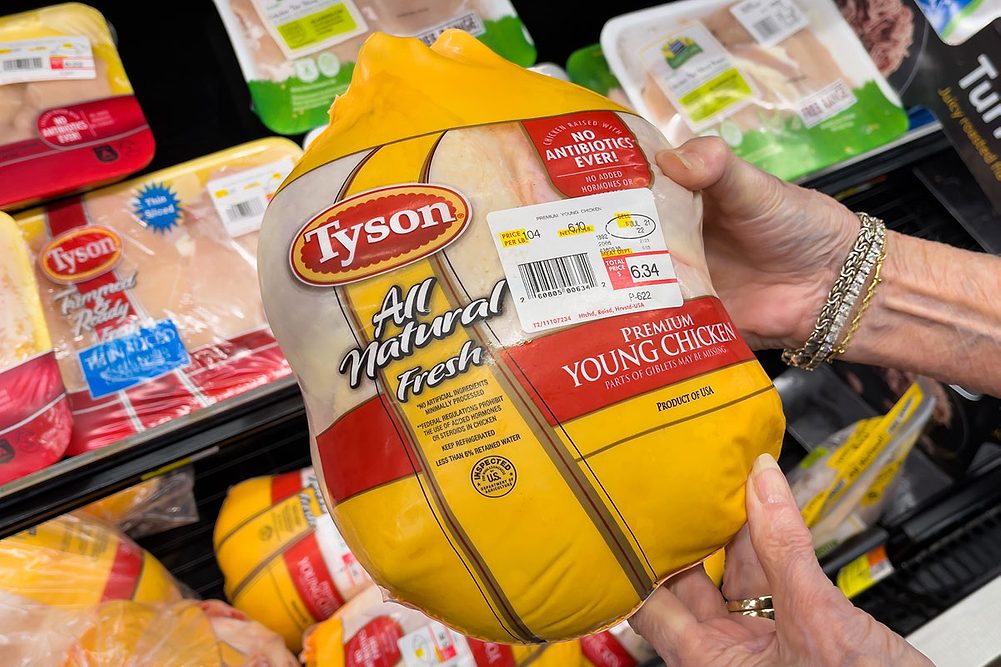SPRINGDALE, ARK. — Tyson Foods Inc. continues to test new strategies to get the company back on a profitable track in fiscal 2023, with ongoing Chicken business segment challenges remaining a priority. The company’s Aug. 7 announcement that it will close four more poultry processing plants was a prelude to it addressing the headwinds that have made 2023 less than profitable across most of its business units.
For the fiscal third quarter ended July 1, the company recorded a loss of $417 million, which was a sharp contrast with the same quarter the previous year when the company earned $750 million, equal to $2.14 per share on the common stock. The share price of Tyson Foods’ stock at the close of markets on Aug. 4 was $56.46 and dipped to $50.88 in morning trading on Aug. 7.
Sales declined in the quarter to $13.14 billion, compared with $13.49 billion during the same period last year.
Tyson’s Chicken segment reported an operating income loss of $314 million, compared to an operating income of $277 million during the same quarter of 2022. Sales of $4.21 billion were slightly lower than the previous year’s $4.37 billion. For the previous nine-month period, however, chicken sales reached $12.9 billion, an increase compared with the same period last year of $12.34 billion.
“Market conditions in chicken are still challenged with commodity prices across most cuts remaining significantly lower compared to last year,” said Donnie King, president and chief executive officer, during an Aug. 7 conference call with analysts.
He pointed out, however, the company has taken action to improve operating income by $100 million, resulting in a sequential increase, resulting from closing two other poultry plants earlier this year and converting two other processing facilities to boneless operations. Tyson Foods expects chicken production will decline 3.5% year-on-year driven by lower pricing, but partially offset by volume growth.
“The decrease in pricing reflects the challenging commodity market,” Mr. King said.
He also addressed the company’s decision to backtrack on its “no antibiotics ever” labeling for Tyson branded chicken during the quarter, as it transitions to a “no antibiotics important for human medicine” policy. He said data suggests the use of ionophores may result in more uniform births and consistent bird weights.
“In turn, we can more accurately forecast supply and demand, helping to meet the needs of our customers and consumers,” Mr. King said. “And I want to emphasize that we will continue to evaluate all options like these across all of our businesses.”
In the Beef segment, Tyson posted operating income of $66 million in the quarter, down from $533 million in the same quarter last year. Sales in the third quarter were flat at $4.956 billion, which compared with $4.959 billion in 2022, while volume declined by 5.3%.
Industrywide cattle herd liquidation is resulting in lower supply, which is pushing prices higher and diminishing spreads and making export trade more challenging.
“Beef is likely to continue to face headwinds, and we don’t expect the ongoing tightening of (the) cattle supply and spread compression to abate until herd rebuilding is well underway,” Mr. King said.
Tyson’s Pork business sustained an operating loss of $74 million in the quarter, which compared with operating income of $25 million in 2022. Sales of $1.32 billion were slightly lower than last year’s $1.61 billion with volume and price declining 1.8% and 16.4%, respectively. The company also felt the impact of a fire at its Madison, Neb., pork processing plant in April, which halted operations there through the beginning of May.
“Revenue was down 18% driven primarily by lower pricing due to softer demand,” Mr. King said. “The operating loss of the quarter was $70 million, as spread compression continued to pressure our markets. This was exacerbated by market pressures in our live operations, lower exports, and the operational impact of a fire at our Madison facility.”
Prepared Foods continues to be a bright spot for the company, with third-quarter operating income topping $206 million, compared with $186 million in the same quarter last year. Segment sales lagged slightly at $2.38 billion compared with $2.44 billion in 2022. Year-to-date sales are leading last year’s with $7.34 billion through the last nine months compared with $7.17 billion during the same time last year.
Categorizing the segment as a growth pillar for the future, Mr. King said Prepared Foods delivered better-than-anticipated margins, at 8.6%, higher than any other business unit for the quarter and 1% higher than last year’s third quarter.
“The (Prepared Foods) business performed well in Q3,” Mr. King said. “In retail, our core business line saw strong volume growth in the quarter and continued to gain pound and dollar share.”
He added: “I’m encouraged by the improvements we made this quarter, including our Tyson core business lines that continue to outpace our peers in volume growth.”



